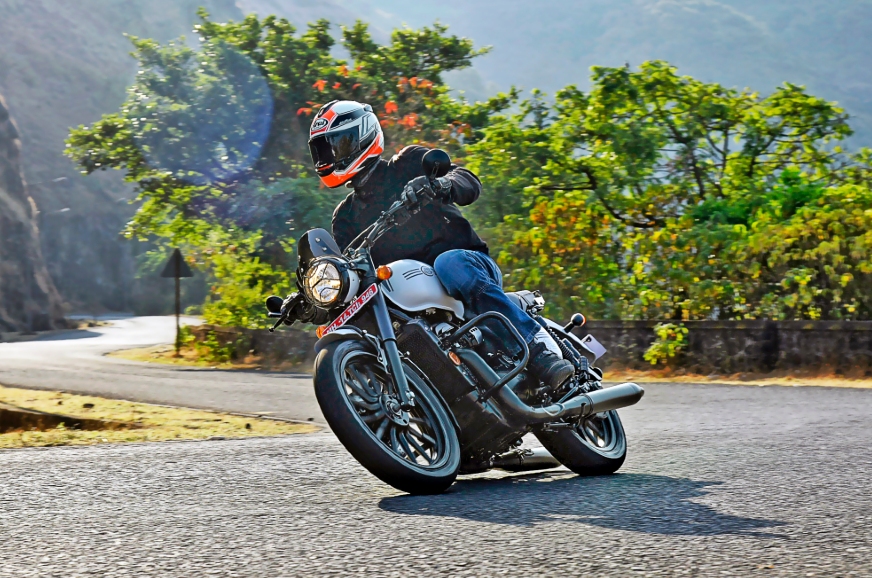
The bike you see here is not a replacement for the current Jawa Forty Two, and will sell side-by-side in the brand’s showrooms. While most of the obvious changes are style-based, there are some mechanical improvements hidden under the skin as well.
New Jawa Forty Two design
Internally known as the Forty Two 2.1 – 2.0 was what the company called its BS6 model – the new Forty Two brings in quite a few design changes, but perhaps the most relevant is the switch to alloy wheels. These black wheels support tubeless tyres and they will be available as accessories for Classic Jawa customers and older Forty Two owners.
Gelling with the alloy wheels is a blacked-out theme on the engine and exhaust pipes, just like on the Jawa Perak. There are new pin stripes on the wheel and a fat racing stripe over the fuel tank as well. Both of these details incorporate the name Classic Legends to remind people about who makes Jawa motorcycles in India.
The bar-end mirrors you see on this bike are standard equipment, while the headlamp grille, small flyscreen and rear metal rack can all be bought as accessories. Those mirrors do make contact with your hand, but they work well and also don’t get in the way too much while filtering through traffic.
The company has also given the bike a new set of switches, including a small button to scroll through the new trip meters. However, the tiny digital screen is quite basic and you don’t get things like a clock, a gear position indicator or a trip computer.
Overall, the Forty Two carries these changes quite well and the design still looks handsome, with the only eyesore being the gap between the rear fender and the tyre. The new Forty Two will be available in red, white and black colours, but if you prefer the classic chrome-and-silver look of the original Forty Two, that bike will still be available in all of its six colour options.
New Jawa Forty Two mechanical changes
Jawa says that it has strengthened the chassis in strategic points and also adjusted the preload in the front suspension. This is meant to reduce the tendency of the bike bottoming when riders keep the front brake held over speed breakers.
Neither of those things are something you'll spot on a spec sheet, but what does catch the attention is that with a kerb weight of 171kg – the new Forty Two has lost around a kilo of weight. This has been achieved by removing the earlier catalytic convertor from underneath the bike. Now, there are two smaller catcons situated where the exhaust pipes emerge from the engine.
There have also been some changes within the engine that have actually resulted in a small increase in power – it’s up by 0.8hp. This is through further refinements made to Jawa's Cross Port technology that debuted in the company's BS6-compliant bikes last year. Essentially, the Cross Port system allows the gases emerging from both exhaust ports in the cylinder head to interact with each other before they exit via the dual exhaust pipes. The latest revisions have further revised the profiles of these ports to make them more efficient. The company says this enables a more precise functioning of the lambda sensor as well as better flow of exhaust and intake gasses, which results in the power increase.
New Jawa Forty Two riding experience
So how does all this translate to the road? Well, the increments are small, but they are noticeable. Whether the bike is actually faster is something only a VBox test will reveal, but the Jawa’s engine does feel a little more involving. The difference is felt in the slightly stronger mid-range, which is a welcome change over the old bike’s flat power delivery. Another upside is that the exhaust sound seems to pack a slightly deeper pulse and it sounds a little crisper.
The fun factor around corners has increased too because the company has redesigned the side stand so it doesn’t scrape quite as easily. The bike is light and eager, and there's quite a lot of fun to be had before the side stand, and inevitably, the exhausts start to scrape the road.
It's not just the dynamics that have improved. Jawa has also redesigned the seat pan while using a higher density foam. We didn’t get enough time with the bike to see what it’s like all day, but this seat is undoubtedly much more supportive than the old one. The seat height remains unchanged and the Jawa still has lower body ergonomics, which aren’t the best for tall riders. Ride quality is slightly on the firm side, but bumps are dealt with well.
It's been a long time since we last rode a normal Jawa motorcycle, but it's a good reminder that the relatively light and powerful Jawa is definitely the sportiest of the current crop of classic motorcycles, including the Royal Enfields, the Honda H’ness CB 350 and the Benelli Imperiale 400. On the other hand, the only really classic thing about this bike is the way it looks. Whether that’s a good or bad thing completely depends on what you want from your motorcycle.
New Jawa Forty price
Jawa tells us that all the mechanical- and feature-based changes you see on this bike will soon be available on the normal Forty Two and the Jawa Classic. This new Forty Two will only be available in the dual-channel ABS variant and be priced higher than the standard model at Rs 1.84 lakh.
The new bike presents marked improvements, but the big challenge for Jawa remains its ability to meet demand and prove its reliability. This is something we hope to see from the company over the course of 2021.
from Autocar India - Bikes https://ift.tt/3b1BPLY
via YouCabri

No comments: